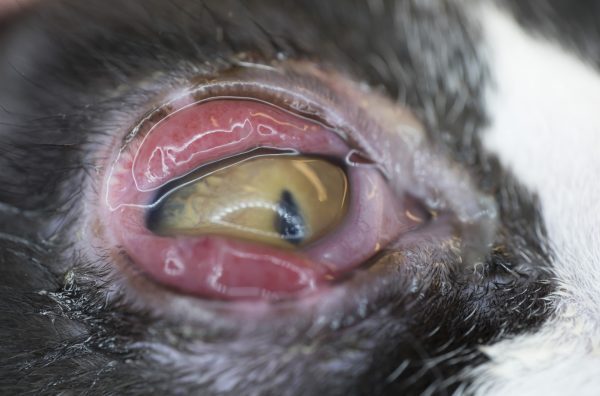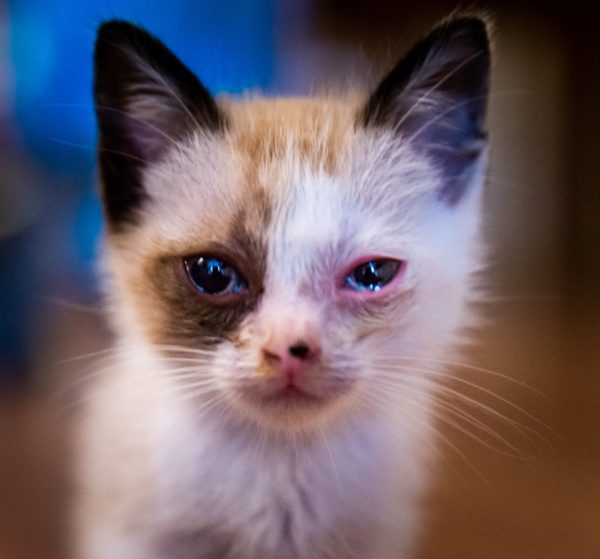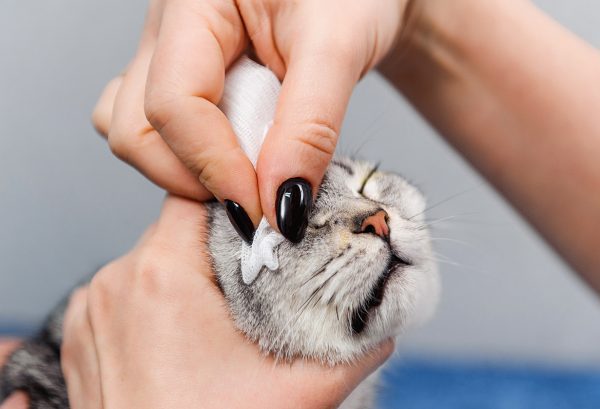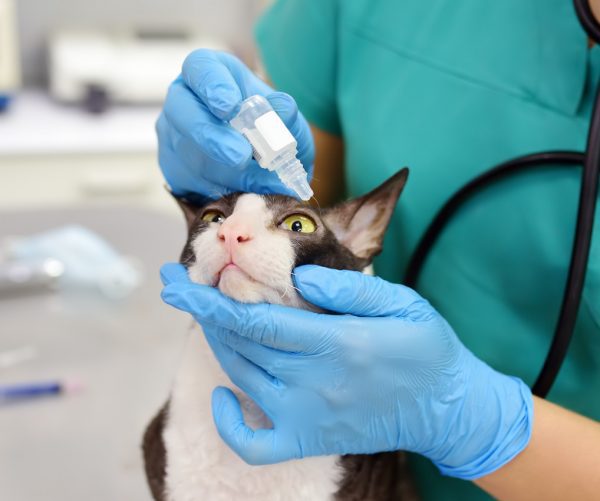What Is Cat Conjunctivitis?
Conjunctivitis in cats is quite common. Most felines will have at least one of these eye infections during their lifetime. Conjunctivitis (also known as pink eye) occurs when the conjunctiva gets inflamed and becomes red and swollen. The conjunctiva is a thin mucous membrane (similar to the lining of the nose or mouth) that is inside a cat’s eyelids and on the outside of the eyeball.
The conjunctiva protects a feline’s eyes from dirt, bacteria, and other harmful substances. It also helps lubricate the eye and contains antibodies that prevent eye infections. Cat conjunctivitis can occur in one or both eyes.
Symptoms of Conjunctivitis in Cats
When looking at pictures of cats with conjunctivitis, the redness and swelling of the eyes is the most obvious symptom. Other signs of conjunctivitis include:
- Squinting or closing the eye
- Excessive blinking
- Eye discharge that is cloudy white, yellow, or green
- Pawing or rubbing the eye
- Excessive tearing or watering
- Sensitivity to light

Causes of Conjunctivitis in Cats
Conjunctivitis in cats is divided into two types: infectious and non-infectious. It is important to know the underlying cause of the infection to determine the appropriate treatment. For this reason, a cat with conjunctivitis should always be brought to the vet.
Although this eye infection is treatable, chronic conjunctivitis in cats can result from infections caused by feline herpesvirus. Periodic flare-ups—especially after stressful situations such as travel, boarding, illness, or surgery—can be expected with this disease.
Although any feline can develop conjunctivitis, it is most common in kittens who have not developed immunity to the germs that can cause the infection. In addition, felines who suffer from a disease that suppresses the immune system—such as feline immunodeficiency virus (FIV) or feline leukemia virus (FeLV)—may be more vulnerable to developing this eye infection.

Infectious Causes of Conjunctivitis
Bacteria, fungi, or viruses are the most common causes of infectious conjunctivitis in cats. A common virus resulting in the infection is feline herpesvirus type-1—also known as feline viral rhinotracheitis (FVR). Feline calicivirus is another virus that can cause conjunctivitis in cats.
Bacteria that can cause this type of infection include Staphylococci, Streptococci, and Chlamydophila. In most cases of infectious conjunctivitis, the infection can spread from one feline to another. Because of this, any cat with conjunctivitis should be separated from other felines in the household until the infection clears.
Non-Infectious Causes of Conjunctivitis
Non-infectious conjunctivitis is caused by an irritant in the environment. These irritants can include allergens, dust, mold, smoke, certain types of plants, air fresheners, or shampoo. In some long-haired breeds—such as Persians and Himalayans—a genetic condition called entropion may result in conjunctivitis. Entropion is when a portion of the eyelid is inverted or folded inward against the eyeball, which can cause the eyelashes to constantly rub against the eyeball. When dust or another irritant gets caught in the eyelashes, it may get trapped in the eyelid and lead to an infection.

Is Cat Conjunctivitis Contagious to Humans?
Neither form of cat conjunctivitis is contagious to humans. However, humans can spread the infectious form to other cats by touching them. This means that anyone petting a feline with herpesvirus type-1 or an active case of conjunctivitis should always wash their hands before handling or petting another cat.
Diagnosis of Cat Conjunctivitis
A vet will examine a cat’s eye with an ophthalmoscope to look for foreign objects, blocked tear ducts, corneal injury, or other type of eye injury. Additional tests may include fluorescein eye stain, tearing tests, or blood/urine tests to determine if the infection is related to a systemic condition. The vet may also take a culture or specimen of the eye discharge. The vet will also consider other symptoms that appeared with conjunctivitis, such as respiratory issues. If this eye infection recurs frequently, the vet may recommend an FIV blood test. Most cases of conjunctivitis in cats are treated as being the infectious type.
Cat Conjunctivitis Treatment
Treating conjunctivitis in cats usually involves eye drops or ointments that contain broad-spectrum antibiotics (to control the infection) and anti-inflammatory drugs (to reduce inflammation). Most forms of this eye infection will resolve within a few weeks.
Determining how to treat conjunctivitis in cats will depend on whether a specific diagnosis can be made. For example, if the conjunctivitis is caused by Chlamydophila or Mycoplasma, the vet will prescribe an azithromycin oral antibiotic and/or a tetracycline ophthalmic ointment. For allergic or eosinophilic conjunctivitis, a topical corticosteroid ointment or drops will be prescribed, along with topical medications to decrease the allergic reaction.
Conjunctivitis caused by the herpesvirus may require antiviral medication in severe cases. In addition, L-lysine or Interferon-alpha may be used as an immune stimulant for felines with recurring infections.

Home Remedies for Cat Conjunctivitis
Some owners turn to the Internet for a cat conjunctivitis home remedy—hoping to save money by not going to the vet. However, some home remedies—such as using apple cider vinegar for cat conjunctivitis—can be extremely dangerous and can result in further eye injuries. Apple cider vinegar can cause severe chemical burns to the cornea—and may result in additional eye problems.
How To Give Eye Drops to a Cat
If the vet recommends eye drops to treat cat conjunctivitis, here are some tips for successfully getting the drops in the feline’s eyes. The task may be easier with two people—one to hold the cat and one to administer the drops. YouTube has several videos demonstrating different techniques. The vet may also demonstrate how to correctly give eye drops.
- Wash hands before administering the medication. This prevents contamination and the spread of infection.
- Gently clean any discharge from the eye with warm water and a washcloth.
- Position the cat on a tabletop or lap. Swaddle them in a towel to keep them secure and to prevent them from scratching. One person should secure the cat while the other person administers the drops.
- With one hand, cradle the head under the jaw using your non-dominant hand—placing your thumb on one side and fingers on the other. Gently tilt the head up to make it easier to get the drop into the eye.
- Hold the bottle pointing downward with your thumb and index finger of your dominant hand. Hold the applicator tip about an inch from the eye. It may be helpful to rest your hand on the cat’s head to steady it.
- Squeeze the bottle and quickly dispense the prescribed number of eye drops. Aim for the center of the eye.
- The cat will blink and disperse the medicine.



